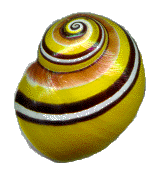



Polymita Ecology Page
HOMEPAGE - TAXONOMY - DISTRIBUTION - LITERATURE
Yearly Life Cycle
The Polymita tree snails have a yearly life cycle which is closely coupled to climatic conditions,
specifically the sub tropical rainy and dry seasons of the coastal habitat. The yearly life cycle of
the Polymita begins in the spring with the first warm rains. Eggs hatch and adult snails wake up
from their aestivation (hibernation). The snails grow, mate and lay eggs from spring thru fall, mid
to end of May through November. Aestivation usually begins around the first dry weather in
October or November. These events are can be triggered or stopped by localized weather
conditions. Flooding and long dry periods can affect the Polymita populations by dessication
or death of the eggs by prolonged flooded conditions.
Reproduction
Polymita is a hermaphroditic gastropod, that is, it is both female and male. However, this does
not obviate the need for copulation by two individual snails. Mating occurs during July and August
with egg laying following during the heavy rains of September. The Polymita hollows out a shallow
tunnel / chamber in the humus soil near the host tree and lays up to two dozen whitish eggs.
The eggs hatch during the first warm rains of the spring and the small perfectly formed Polymita
crawl toward the nearest bush or tree.
Growth
Polymita have an slightly oblong helical shell which grows in a dextral direction about the central axis.
Very rare individuals have been found to be sinistral, that is, growing in a left handed direction about
the central axis. The Polymita have a natural life span of two to four years and exhibit clearly marked
lateral varices or growth marks indicating the yearly arrest in growth which occurs during aestivation.
Aestivation
The Polymita undergo a period of dormancy or aestivation starting in November or December and
which lasts through May or April of the next year. Upon sensing dry conditions, shorter days and lower
temperatures, the Polymita finds a protected location and secretes a mucus seal or epiphragm. This seal
protects the snail from dehydration during the winter period of lessened humidity and rain. The Polymita
breaks out of aestivation during the beginning of the rainy season in April or May.
Food
The Polymita snails feed on the confervoid algae, fungi, sooty molds and lichens which grow on
subtropical hardwood trees and shrubs . Polymita do not eat the leaves or bark of the host tree. Feeding
paths may be seen where the snail has scraped the algae and lichen growths with their radula. The quality
of the habitat, that is, the amount of food and type of food, affects the shell growth of the Polymita.
The Polymita is a welcome guest in Coffee and Guava orchards of the Oriente province as they eat
the sooty molds on the leaves and branches of the trees.
Habitat and Host Trees
Polymita inhabit the subtropical hardwood forests growing on the coastal plains and mountains
of the Eastern end of Cuba. The Polymita displays a marked preference for certain tree species. The
preferred or host tree is; Hicaco (Chrysobalanus icaco). Other host trees are varieties of Poisonwood
(Metopium toxifera, brownei ), Gumbo Limbo (Bursera simarouba), Hicaquillo (Coccoloba retusa),
and other smooth barked hardwoods.
Predators
Polymita are preyed upon by a variety of vertebrates and invertebrates; birds, rats, and the most
destructive enemies of all; bulldozers and ensuing destruction of habitat. Habitat destruction is by far
the greatest threat to the Polymita. The most common natural predation is by the Hook-Billed Kite
[Chondrohierax uncinatus wilsonii] occurring locally in eastern Cuba, wherever its food, Polymita sp.,
is available. The Hook-billed Kite feeds primarily on land snails, both arboreal and terrestrial. The
animals are neatly extracted, without shell breakage, and piles of shells can be found beneath its perches.
In Cuba it feeds chiefly on tree-snails. In Grenada and elsewhere it takes large terrestrial snails.
Chondrohierax is less specialised than Snail Kites of the genus Rostrhamus, as it also eats frogs,
salamanders, insects, and caterpillars, as well as snails.
 |
|
Hook-Billed Kite |
HOMEPAGE - TAXONOMY - DISTRIBUTION - LITERATURE